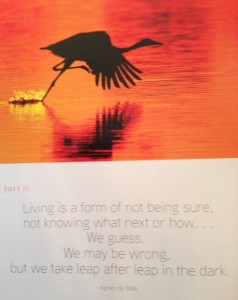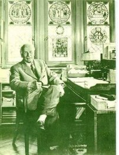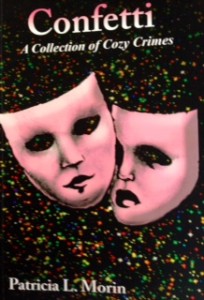Read Pat’s latest reviews for Theatrius:
 PatMorinWebmaster
PatMorinWebmaster
Five-Star Review for “Confetti” from the San Francisco Book Review
 I couldn’t believe, after one four star rating (Mystery Montage,) and another four star rating (Crime Montage), I finally accomplished the best rating for my short story collection Confetti, a collection of Cozy Crimes! I don’t think as authors we realize what book, what story, what sentence, what word, will grab a reader, reviewer, friend, or neighbor. All our stories are in some way leaps of faith that our hearts and minds and imagination will be presented so someone out there will smile and say, “Hey, this was a great read.”
I couldn’t believe, after one four star rating (Mystery Montage,) and another four star rating (Crime Montage), I finally accomplished the best rating for my short story collection Confetti, a collection of Cozy Crimes! I don’t think as authors we realize what book, what story, what sentence, what word, will grab a reader, reviewer, friend, or neighbor. All our stories are in some way leaps of faith that our hearts and minds and imagination will be presented so someone out there will smile and say, “Hey, this was a great read.”
“Oh, just delightful! This book, generally, does not take itself too seriously. It is a collection of short stories, all tied together by the commission, contemplation, connivance or conundrum of murder. The problem of such a collection is to make the characters different from one story to the next. Patricia L. Morin speaks with different voices as her characters, mostly in the first person, involve themselves or are involved in homicide.
“When an intellectual college student has oxygen starvation amnesia, she talks in short clipped sentences, giving the impression that longer thoughts are just too much for her to manage. When a stoner has a run-in with a Good Samaritan, he is under the influence and his lack of coherent thought prevents him from recognizing the truth of his predicament. An elderly man contemplates his life and marriage, striving to find a reason to continue one or the other. A successful stock trader is forced by the murder of her sister to examine her own motivations and desires.
“There is more, however, to character development and tone than sentence structure alone and the author successfully creates, in a very short time and with quick strokes, enough of each character to allow the reader to picture and fill in the rest. There is just enough description for a short story, with such phrases as ‘eyes of ice’ or ‘he had a twinkle in the corner of his crinkled eyes.’ These would make good short plays, each about one-quarter to one-half hour long. Most of them have a clever twist or ending, often unexpected, usually foreshadowed for the amateur sleuths among us. The book is not clinically gory so the characterizations are not lost in the awful details. I liked the book: it is easy reading, and I found myself laughing at the twists and admiring the writer’s craft.”
—Ralph Peterson, San Francisco Book Review
Click here to read published book review
The Never-Ending Process of Purpose
Traveling cross country from San Francisco to our new New York City apartment with a caravan full of “stuff,” and the blaring sun reminding us how burning hot it can be, I thought about the word purpose, a purpose unto itself. Purpose was all around me. In fact, we were in a Bed, Bath, and Beyond store, and I heard this song I don’t know, and the crooner is singing about finding something to believe in or not living. Those weren’t the exact words, but I was holding too much “stuff” to write it down.
But what I did get to do, and I thought it quite exciting—wish I had a video camera—was to interview people I had met about what they thought when I said the word purpose. What the heck, I thought. Michael Black hit the salient features of “purpose,” and I couldn’t agree more. Carole added some purposefulness to the word, and Rita gave us many writers’ and philosophers’ quotes on the subject. All great in their own way. Susan and Hannah had existential definitions for the words as their day and adventures took them into the here and now, the ever important daily purpose, or describing obstacles to achieving one’s purpose.
A young bartender we met, Danielle, a wise 24 year old, answered that question. Here is a bit of the conversation. Larry, my husband, added a few things, also.
P: What is purpose?
D: It is cause and effect, everything happens for a reason.
P: Is it transient?
D: Yes it is.
P: So it changes.
D: Of course.
P: Does it change as your life changes, or as the experience changes? Can one experience have several purposes, or is it that you have to go through an experience, and in that experience there is a purpose?
D: For me you have to go through an experience that has a purpose, then you have another experience and that has a purpose.
L: Pat, why the meeting with Danielle and Tierney (another interviewee—is that a word?), what was the purpose?
D: Hey, that’s what I said when I went home last night. I met those people for a reason, not just to serve them wine. If I meet this Joy (a person we recommended) and she helps me with something that is life changing, then that’s the purpose of our meeting. You become the purpose.
So what I have gleaned about “what is purpose” is this: There’s a silent movement to it. Its vicissitudes in life are individual, constantly changing, and very important. There may even be an ingredient of serendipity to the mix. My cousin, Wally Gold, a songwriter (who wrote “It’s my Party” and “It’s Now or Never” and others) said that because of serendipity, he met Aaron Schroeder, the music king at that time, and that changed his life and his life’s purpose. Maybe for me, the benefit of this trip, in a spiritual way, was to help people take a look at what is truly meaningful to them.
Depth
When thinking about the word “depth,” it is hard to imagine what it really means. I naturally think of water (the distance below the surface), a drawer (distance between front and back), maybe a jungle (distance to the most remote part), or maybe even art (depth of color or three dimensional forms). When it comes to the individual, depth become harder to envision. What is the quality of being deep? Is it experiences layered with experiences layered with even more experiences? Is it a profound or intense state of feeling, as in the depth of misery?
What life could be lived, or experiences gained, without self? It is another word that is hard to imagine. Self is the core of our being, the essence of what makes us home in our body. But when I imagine it, it’s seems as endless as an oil shaft, like our center core is unlimited. There is no single image that identifies it. One women I saw in therapy said that she had lost her self, and was grieving that loss. She no longer acted in a way that felt authentic to who she was. Whew! Right?
Psychology is the study of the Psyche. Modern Psychology can help us understand more about  that “self”. With Depth Psychology, we learned that the psyche is more than a conscious mind, it had depth, illuminations which are not visible, the unconscious. Carl Jung (picture to left) believed that there were aspects of our psyche that were common to us all. These aspects include images, dreams, the spiritual (soul), art, philosophy, and the para-nornormal. Jung did his doctoral research on the Occult, and studied a fifteen-year-old medium. I believe that these ingredients are also important to what make up the “depth” in all of us, the authentic self.
that “self”. With Depth Psychology, we learned that the psyche is more than a conscious mind, it had depth, illuminations which are not visible, the unconscious. Carl Jung (picture to left) believed that there were aspects of our psyche that were common to us all. These aspects include images, dreams, the spiritual (soul), art, philosophy, and the para-nornormal. Jung did his doctoral research on the Occult, and studied a fifteen-year-old medium. I believe that these ingredients are also important to what make up the “depth” in all of us, the authentic self.
When exploring the characters in your life, as well as your books, or maybe even yourself, probe the most important facets of that character: spiritually, emotionally, their dreams, their fantasies (which few share), their real and imagined desires. That’s what I do to get that added dimension. That way I feel as though I’m not writing about their lives, but of their lives.
The New Way to Create Your Story
The Interactive Way to Write Your Next Book: Crowdsourcing!
 Recently, I was at a meeting with my new publisher and several of the authors from Harper Davis. We discussed “Branding,” and my need to redo the way I brand myself as well as my blog, website, and name. I tend to use Pat Morin, and not the Patricia L. Morin signed on my books and short stories. When discussing the use of name, one of the marketing people suggested I crowdsource an opinion of which of the names I should use. I had never heard of it. Several of the authors had explained that authors are now using crowdsourcing to write their novels. With the help of their fans, their new stories are being created.
Recently, I was at a meeting with my new publisher and several of the authors from Harper Davis. We discussed “Branding,” and my need to redo the way I brand myself as well as my blog, website, and name. I tend to use Pat Morin, and not the Patricia L. Morin signed on my books and short stories. When discussing the use of name, one of the marketing people suggested I crowdsource an opinion of which of the names I should use. I had never heard of it. Several of the authors had explained that authors are now using crowdsourcing to write their novels. With the help of their fans, their new stories are being created.
Wow! First let me define crowdsourcing (and if some/all of you know, please forgive the repetition).
Crowdsourcing is, according to the Merriam-Webster Dictionary, the practice of obtaining needed services, ideas, or content by soliciting contributions from a large group of people, and especially from an online community, rather than from traditional employees or suppliers. The general concept is to combine the efforts of crowds of volunteers where each one could contribute a small portion, which adds into a relatively large or significant result. Crowdsourcing is different from an ordinary outsourcing since it is a task or problem that is outsourced to an undefined public rather than to a specific, named group. Although the word “crowdsourcing” was coined in 2006, it can apply to a wide range of activities.Crowdsourcing can apply to specific requests, such as crowdvoting, crowdfunding, a broad-based competition, and a general search for answers, solutions, or a missing person.
There is even a new platform for writers all over the world launched by CrowdSource, LLC. The new portal, called Write.com, aims to recruit new writers to enrich Amazon’s Mechanical Turk crowdsourcing marketplace.
Authors are able, through this new format, to change endings and rewrite books, as was discussed on LadyKillers Blog before. But now, we can include our fan base to help create the story from the start.
Out with the outline, out with the plotantsers, out with the 1,2,3. In with the new group interactive process: crowdsourcing!
What do you think about all this?
Rejection and Resilience
What interested me the most about the rejections that authors received from publishers and agents, beside the types of letters, and diversity of the language in the negative responses (some very positive, also), was the reaction of the author. I know when my reject slips started flooding in, I felt angry, defensive, bewildered, and sometimes indignant (usually not all at the same time). I worked hard to keep my spirits up, and push through a bit of despair to send my stories to the next publisher, hopeful of an acceptance.
We’re resilient. We’ve bended, adapted, shifted, sometimes in ways we never thought we could. I most certainly did not handle all my rejections effectively. I cursed out several agents (the one who sent the fortune cookie size response). I even wrote to one agent and told her how rude she was in her rejection letter, and would suggest no one hire her—since we do have to pay them for services.
Anyway, the resilient person, moi, does not always, to this day, handle refusal of my work well. However, the strength, I believe, is in the ability to rebound. According to Robert Brooks, Ph.D, there are four concepts that help people when confronted with rejection. All four have been touched upon in The Ladykillers Blog this week at one point or other. I’m just putting them all together.
- Avoid self-defeating assumption. Rejections do not indicate a basic flaw in our personality.
- Don’t magnify the rejection in terms of the impact it has on your life. It is not a forecast of your future. After about 75 rejection slips, I sorta had a hard time believing this one.
- Don’t allow the rejection to derail your dreams. Persevere.
- Learn from the rejection, even if there is no suggestion for change. Seek helpful feedback from others.
- (Mine) reevaluate the agents and publishers, the people you are hoping to win over–they my not be right for you. I’ve had to change my list several times.
- STAY RESILIENT!
Can you add to this list? What has helped you stay resilient? Cat buddies that purr on your lap are acceptable.



